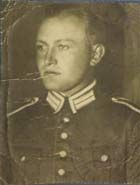Kaiser, Albert Oskar (Geb.Pz.Jäg.-Abt.44)
- Date of birth:
- March 1st, 1910 (Haarbrücken/Bavaria, Germany)
- Date of death:
- August 6th, 1941 (Jemirowka - Eastern Front)
- Buried on:
- Soviet War Cemetery Kirovohrad
- Nationality:
- German
Biography
Do you have more information about this person? Inform us!
- Period:
- Second World War (1939-1945)
- Rank:
- Hauptmann (Captain)
- Unit:
- Chef 1. / Gebirgs-Panzerjäger-Abteilung 44 / 1.Gebirgs-Division
- Awarded on:
- August 21st, 1941
“During the campaign against Russia, on the 30.06.1941, Hauptmann Kaiser was the commander of a mobile group consisting of a Kradschützen Zug, a 1/2 Zug of Panzerjäger, one 2 cm and two 8.8 cm guns as well as some Pionieren.
With these weak forces (no more could be spared) he launched a thrust through enemy forces east of Winiki. His group knocked out 10 Russian tanks (up to 40 tons in weight) and smashed several enemy counterattacks conducted by tanks, infantry and motorcycle troops. This was in spite of the group’s own considerable losses due to the heavy enemy fire, which included one 8.8 cm gun that was quickly knocked out. Here it was once again only the commander’s bravery and toughness that ensured the position could be held.
Many such small battles were fought with great skill and daring, such as that on the 05.07.1941 around and in Trembowla as well as on the 06.07.1941 around Korostkow. These also resulted in very heavy losses for the Russians. On the 15.07.1941 Hauptmann Kaiser succeeded in eliminating the enemy defenders on the reverse slope of Hill 341 (northwest of Galusinzy) to the last man. Afterwards he made the independent decision to take advantage of the enemy’s precarious situation, and he launched a bold attack with his Kompanie against the numerous concrete bunkers of the Stalin Line despite the lack of artillery support. This attack saw Kaiser and his men penetrate the enemy line (it was for this deed that I previously requested that he be named in the Wehrmachtbericht).
After eliminating two enemy munitions columns on the 17.07.1941 south of Meshiroff, fighting tough breakthrough battles through Shmerinka, and other subsequent skirmishes, Hauptmann Kaiser launched a surprise attack through Mogileowka towards the bridge over the Bug river that had been primed for demolition. By eliminating the bridge’s garrison he succeeded in taking this structure undamaged, thereby enabling the Division’s great success that would take place the next day. Shortly afterwards he launched a thrust on his own initiative against the airfield at Sutisi, which was captured. Several enemy aircraft along with other materiel fell into our hands.
On the same night (17./18.07.1941) Hauptmann Kaiser continued to push forwards into the rear of strong enemy forces (numbering in the tens of thousands), and after a strenuous forward movement along muddy roads he was able to reach Luka. There he smashed an enemy counterattack and launched his own assault which resulted in the capture of the bridge near Vinnitsa following fierce battles that lasted until midnight. Thus the Soviet retreat route over the Bug was blocked, and the enemy army was encircled. All crises were overcome by the personal boldness of Hauptmann Kaiser, and much materiel was captured.
On the 19.07.1941 Kaiser expanded his bridgehead to the north on his own initiative and, after another assault on the 20.07.1941 that brought great losses to the enemy, was ultimately able to reach North Vinnitsa. On the next day (21.07.1941) Hauptmann Kaiser fought through Niemirow-Süd, thrusting to a depth just north of Brazlaff against further enemy forces until being forced to halt at nightfall. Despite being wounded in this battle by a shot through the calf, he stayed with the attack spearhead.
The next day, on the 22.07.1941, he made another bold thrust to a bridge that was taken the next day after a hard fight. In this battle he was lightly wounded for the second time by shell splinters to his arm and face.
The captured materiel that Hauptmann Kaiser has brought in since the Polish campaign (tanks, guns, aircraft, etc.) is too numerous to be counted.
Hauptmann Kaiser, already a holder of the Iron Cross First & Second Class as well as the General Assault Badge, is particularly worthy of the high honour of the Knight’s Cross.”
Awarded posthumously.
- Period:
- Second World War (1939-1945)
- Rank:
- Major
- Awarded on:
- April 10th, 1943
- Period:
- Second World War (1939-1945)
- Period:
- Second World War (1939-1945)
- Period:
- Second World War (1939-1945)
- Rank:
- Hauptmann (Captain)
Sources
- Photo 1: Familie
- Photo: Family
- - THOMAS, FRANZ & WEGMANN, GÜNTER, Die Ritterkreuzträger der Deutschen Wehrmacht 1939-1945.
- Fellgiebel W.P., Elite of the Third Reich, The recipients of the Knight's Cross of the Iron Cross 1939-1945: A Reference, Helion & Company Limited, Solihull, 2003, ISBN 1-874622-46-9
- Die Träger des Ritterkreuzes des Eisernen Kreuzes 1939-1945
- http://www.lexikon-der-wehrmacht.de
- Axis History Biographical Research via Axis History Forum
- Detailansicht







